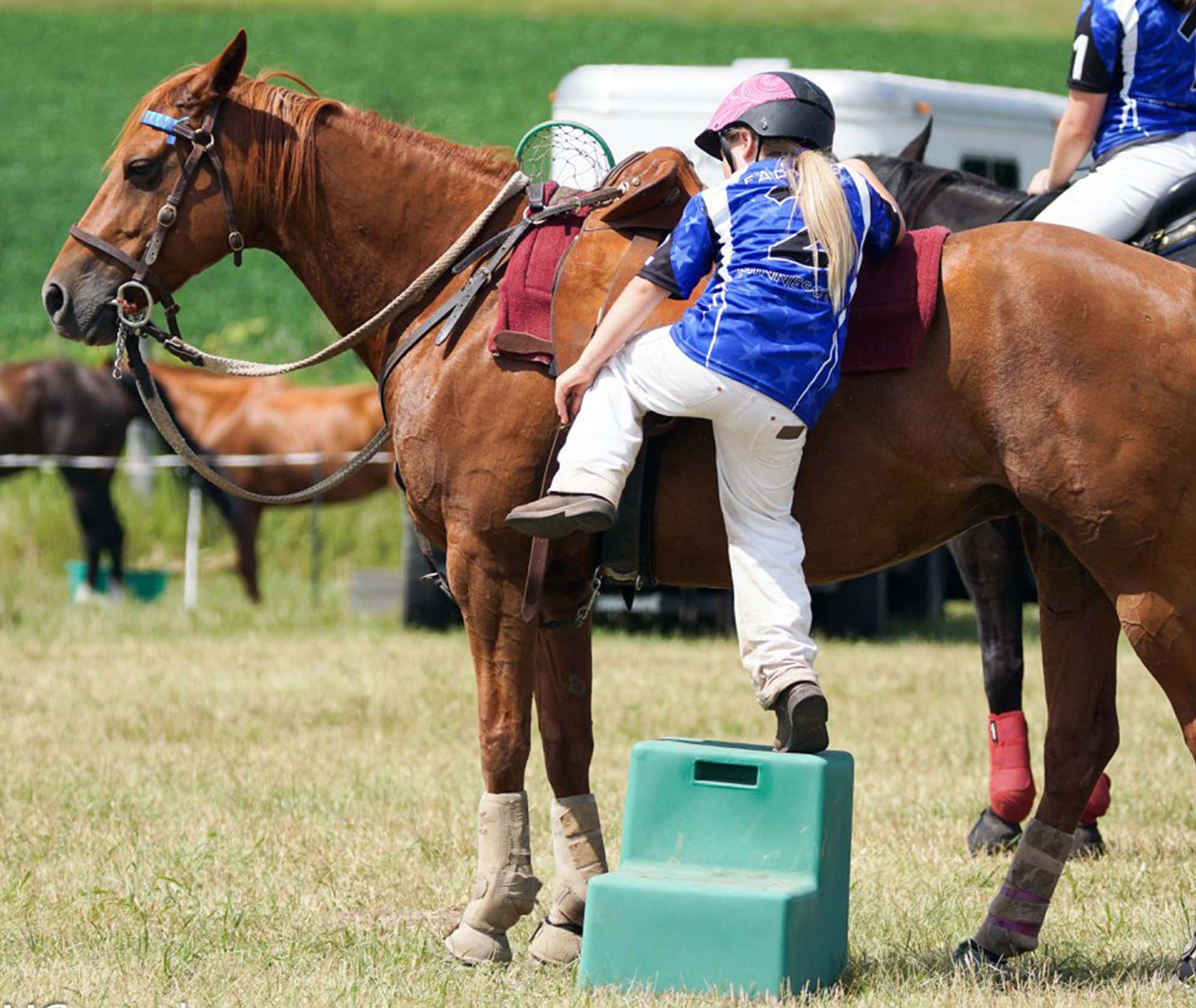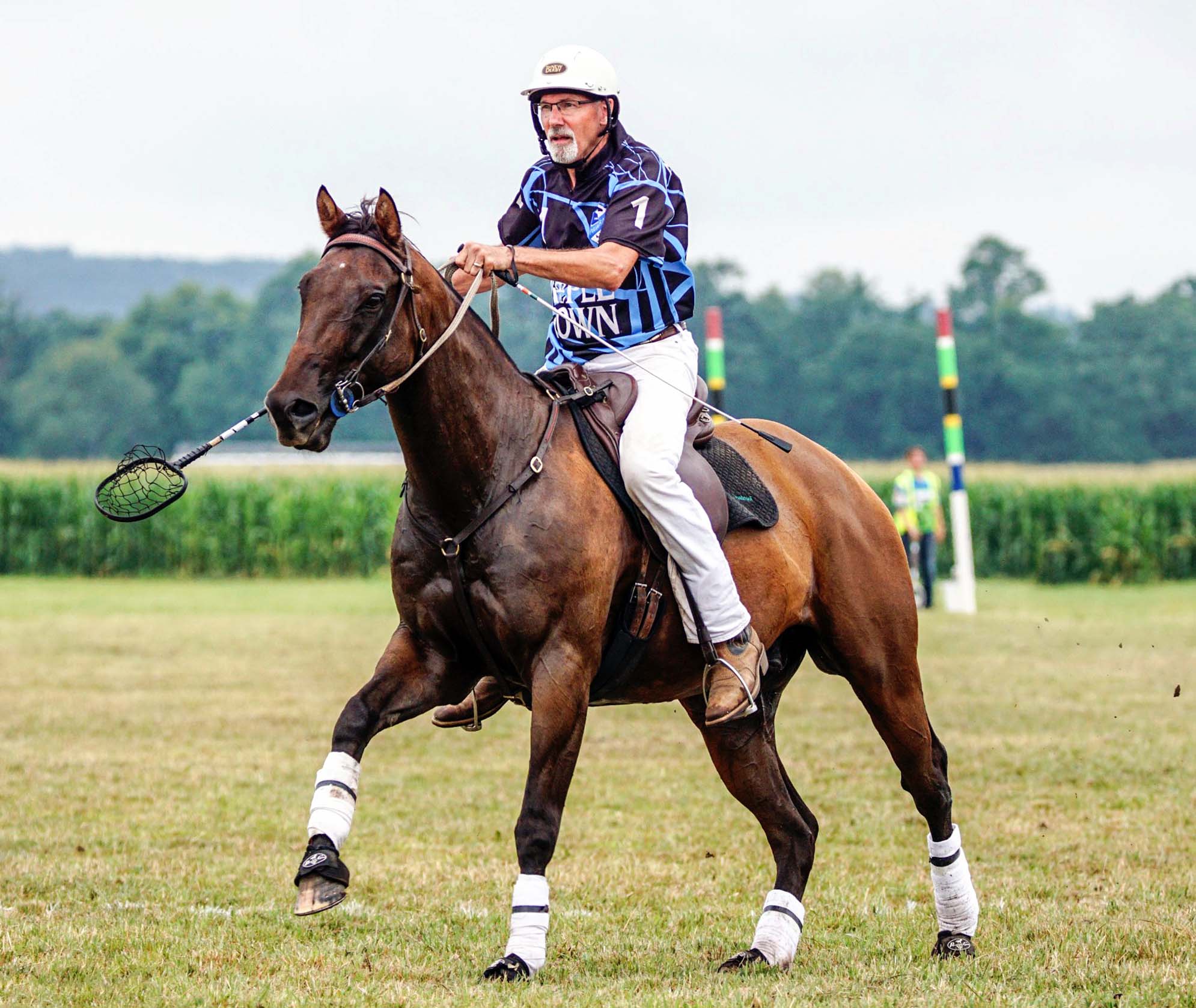Beginning Your Polocrosse Journey
Home / Getting Started
Beginning Your Polocrosse Journey
Home / Getting Started
Polocrosse 101
In polocrosse, two teams of three players each compete on a field that is approximately the size of a football field. Each player uses a racquet to carry, catch, and pass a rubber ball between teammates while riding their horses. The objective of the game is to score goals by throwing the ball through the opposing team’s goal posts.
Dig deeper into the sport using the links below:
How to Play
There’s plenty of ways to get started in the sport of Polocrosse! See what options may work best for you.
Rules of Polocrosse
Like any sport, Polocrosse has its own unique set of rules. Make sure you brush up on the latest rules!
History of Polocrosse
Learn about the fascinating beginnings of Polocrosse and how it evolved into the game we play today.
Instructional Videos
See some basic polocrosse instructional videos.
FAQs
Find answers to the most frequently asked questions.
How to Play
There’s plenty of ways to get started in the sport of Polocrosse! See what options may work best for you.
Rules of Polocrosse
Like any sport, Polocrosse has its own unique set of rules. Make sure you brush up on the latest rules!
History of Polocrosse
Learn about the fascinating beginnings of Polocrosse and how it evolved into the game we play today.
Instructional Videos
See some basic polocrosse instructional videos.
FAQs
Find answers to the most frequently asked questions.
Addressing the Basics
What sort of horse do I need to play polocrosse?
You can play polocrosse on any sort of horse (so long as it is not blind in either eye, is not a stallion and is not unfit), but you will find some horses to be more suitable to polocrosse than others, even though polocrosse horses come in a great variety of shapes and sizes.
Horses which have cattle penned, been involbed in pony club, or have 4H experience generally make good polocrosse horses.
Many top polocrosse horses are Thoroughbreds and Quarter Horse crosses, which have great athletic ability, agility, stamina and courage.
Of course, it is easier to learn on an experienced horse but there is no reason why you can’t both learn together. Many of our elite players have commenced their sporting careers on older, experienced horses that are accustomed to the rucks and line outs and tend to follow the ball.


Is there an age limit to play?
No. If you are old enough (or young enough) to ride a horse, you can play polocrosse.
Polocrosse utilizes a handicaps system so that teams can be more evenly matched. Players’ abilities are assessed and rated on a scale from 0 to 10, with 0 indicating a beginning or novice player, while a player rated at 10 goals denotes the highest handicap possible. The rating is an estimate of a player’s worth to their team, taking into account their horsemanship, team play, knowledge of the game, strategy, and sportsmanship.
In matches played by handicapped players (as opposed to open competition where handicaps are not considered), the handicaps of all three players on a side or all six players on a team are added up. If the total handicap of a team is more than the team against which they are playing, the difference is added to the scoreboard. For example, if team blue has a total handicap of 6 goals and team red has a handicap of 4 goals, ‘blue’ would start with a 2-goal advantage.
What gear will I need in order to play?
-
-
- Helmet: Like most horse sports, you will need an equestrian helmet with a 3 point harness.
- Saddle: The most suitable type of saddle is an Australian Stock Saddle, but you can use any saddle as long as it doesn’t have a horn. For safety reasons, all saddles must be equipped with a breast plate, girth and over girth.
- Bridle: Any bridle can be used, but no bits with protrusion are permitted (snaffle with out the full cheek pieces) and reins must be joined.
- Protective Boots/Bandages and Bell boots: Must be on all 4 legs of the horse.
- Rackets & Balls: There are a number of different style rackets available. Check our resources page for details.
-

Addressing the Basics
What sort of horse do I need to play polocrosse?
You can play polocrosse on any sort of horse (so long as it is not blind in either eye, is not a stallion and is not unfit), but you will find some horses to be more suitable to polocrosse than others, even though polocrosse horses come in a great variety of shapes and sizes.
Horses which have cattle penned, been involbed in pony club, or have 4H experience generally make good polocrosse horses.
Many top polocrosse horses are Thoroughbreds and Quarter Horse crosses, which have great athletic ability, agility, stamina and courage.
Of course, it is easier to learn on an experienced horse but there is no reason why you can’t both learn together. Many of our elite players have commenced their sporting careers on older, experienced horses that are accustomed to the rucks and line outs and tend to follow the ball.
Is there an age limit to play?
No. If you are old enough (or young enough) to ride a horse, you can play polocrosse.
Polocrosse utilizes a handicaps system so that teams can be more evenly matched. Players’ abilities are assessed and rated on a scale from 0 to 10, with 0 indicating a beginning or novice player, while a player rated at 10 goals denotes the highest handicap possible. The rating is an estimate of a player’s worth to their team, taking into account their horsemanship, team play, knowledge of the game, strategy, and sportsmanship.
In matches played by handicapped players (as opposed to open competition where handicaps are not considered), the handicaps of all three players on a side or all six players on a team are added up. If the total handicap of a team is more than the team against which they are playing, the difference is added to the scoreboard. For example, if team blue has a total handicap of 6 goals and team red has a handicap of 4 goals, ‘blue’ would start with a 2-goal advantage.
What gear will I need in order to play?
-
-
- Helmet: Like most horse sports, you will need an equestrian helmet with a 3 point harness.
- Saddle: The most suitable type of saddle is an Australian Stock Saddle, but you can use any saddle as long as it doesn’t have a horn. For safety reasons, all saddles must be equipped with a breast plate, girth and over girth.
- Bridle: Any bridle can be used, but no bits with protrusion are permitted (snaffle with out the full cheek pieces) and reins must be joined.
- Protective Boots/Bandages and Bell boots: Must be on all 4 legs of the horse.
- Rackets & Balls: There are a number of different style rackets available. Check our resources page for details.
-
Wondering where to buy equipment?
We have you covered.
Frequently Asked Questions
What is Polocrosse and how experienced of a rider do I need to be to play?
Polocrosse is a team sport that is played all over the world. It is a combination of polo and lacrosse. It is played outside on a field and on horseback. Each rider uses a cane stick to which is attached a racquet head with a loose, thread net, in which the ball is carried. The ball is made of sponge rubber and is approximately four inches across. The objective is to score goals by throwing the ball between the opposing team’s goal posts. Anyone who can ride a horse can play polocrosse, which also helps improve riding skills. All ages and abilities are encouraged to play. Polocrosse is an approved discipline of the United States Pony Club.
What is so special about Polocrosse?
Polocrosse is a unique combination of a thrilling team equestrian sport that is nurtured in a fantastic, family-oriented environment. Often horse sports are generally individual sports and can be very pressure oriented and not much fun, socially. Polocrosse is different. It is about the team working together, competing and having fun on and off the field. You do not have to be an expert horse rider to get started, and men and women of all ages play together on teams. There are three ways anyone can be effective on the field: horsemanship, team play and strategy, and racquet skills. Being good at any one of these three skills is all you need to have impact and be effective in polocrosse. As you advance in your skills, and start doing better in 2 or 3 of the skill areas, your overall effectiveness improves. At tournaments your team is matched with other teams that have like skill levels (called “grades”) so the play is always fair. As you and your horse improve, you can move up to more competitive grades of play.
What if I don’t have my own horse?
No problem. Some of our riders lease horses for the season or for a tournament. The cost to lease a horse for polocrosse varies depending on the arrangement you are able to make with the horse’s owner. Sometimes you may be able to arrange it where you are able to use the horse for free, as long as you are willing to take care of the horse to the owners standards throughout the term of the lease. Other times, the owner may charge a month fee to use their horse in addition to paying for their care and board or charge you a flat fee for using their horse at a tournament.
If you are interested in finding out what horses may be available for lease, please contact our club President, Kristi Johnson or board member Kristy Gusick for help coordinating a horse to lease.
What if my horse isn’t capable of playing Polocrosse?
There are no restrictions as to what breeds can be play polocrosse per the American Polocrosse Association’s Standards of Play. However, not all horses are interested in participating in the sport of polocrosse or are suitable for playing polocrosse. Safety is our primary concern and every horse has to be safe on and off the field. Just because your horse has yet to play is no reason to assume it cannot be conditioned and taught the game quickly. At our annual beginner’s clinics we ofter are teaching/desensitizing new horses to the game and racquets. Stallions are not allowed to play, however, per the American Polocrosse Association.
What equipment do I need to play polocrosse?
Helmet, bell boots and medicine boots or leg wraps are required. A saddle without a horn is also required. Many of our riders use an Australian stock saddle or an English saddle. Polocrosse racquet and ball is also necessary once you have determined this is the horse sport for you.
Where can I find equipment?
If you are just beginning or just want to try the sport out, our club has extra equipment available to use for short term. If you then decide you would like to continue playing the sport, you can order racquets, helmets and other polocrosse equipment from equipment vendors listed on our Resources Page.
What if my horse kicks during a practice or tournament?
Above all, our first priority is the safety of polocrosse riders and horses. We ask that you download, save, and read MNPC Article 15. Addressing Dangerous Behavior to learn about or review Minnesota Polocrosse rules with regard to kicking, biting, and other dangerous behavior.
How can I contribute to the team if I don’t ride?
There is a multitude of ways to get involved with the Minnesota Polocrosse Club! We always need help with managing horses at team practices and tournaments. Some of the activities we need volunteers for are scorekeeping , goaltending, and managing the clock. On warm days we need help cooling down the horse by walking and wiping them down, and by providing both rider and horse with water. Other opportunities for participation are in the management of the club and club activities such as registration, set-up, clean-up, concessions, fund raising, committee work, and board membership on the board. Because we host a number of clinics and tournaments there are ample opportunities for those who want to participate and help the club be successful.
I heard you travel a lot to tournaments. How do I know what to bring?
While our club always hosts an annual PX camp and tournament, many of the other tournaments that we like to compete at are out of state. So each year many of our club members do chose to travel to anywhere between 2-6 out of state tournaments that other clubs across the country host. Part of what we think makes polocrosse so much fun is the opportunity to ‘road trip’ with our friends and families – and our horses! Most tournaments are held in a wide open field with room to set up a PX field and to park several trucks and trailers. Once you arrive at a tournament, you will need to be able to camp with your horse. For more information on traveling with your horse to a tournament, check out the Traveling with Your Horse page on our website. You will also find a detailed checklist there to help you know what to bring when you are packing for a tournament.
Find more polocrosse FAQs at the APA Website
Frequently Asked Questions
What is Polocrosse and how experienced of a rider do I need to be to play?
Polocrosse is a team sport that is played all over the world. It is a combination of polo and lacrosse. It is played outside on a field and on horseback. Each rider uses a cane stick to which is attached a racquet head with a loose, thread net, in which the ball is carried. The ball is made of sponge rubber and is approximately four inches across. The objective is to score goals by throwing the ball between the opposing team’s goal posts. Anyone who can ride a horse can play polocrosse, which also helps improve riding skills. All ages and abilities are encouraged to play. Polocrosse is an approved discipline of the United States Pony Club.
What is so special about Polocrosse?
Polocrosse is a unique combination of a thrilling team equestrian sport that is nurtured in a fantastic, family-oriented environment. Often horse sports are generally individual sports and can be very pressure oriented and not much fun, socially. Polocrosse is different. It is about the team working together, competing and having fun on and off the field. You do not have to be an expert horse rider to get started, and men and women of all ages play together on teams. There are three ways anyone can be effective on the field: horsemanship, team play and strategy, and racquet skills. Being good at any one of these three skills is all you need to have impact and be effective in polocrosse. As you advance in your skills, and start doing better in 2 or 3 of the skill areas, your overall effectiveness improves. At tournaments your team is matched with other teams that have like skill levels (called “grades”) so the play is always fair. As you and your horse improve, you can move up to more competitive grades of play.
What if I don’t have my own horse?
No problem. Some of our riders lease horses for the season or for a tournament. The cost to lease a horse for polocrosse varies depending on the arrangement you are able to make with the horse’s owner. Sometimes you may be able to arrange it where you are able to use the horse for free, as long as you are willing to take care of the horse to the owners standards throughout the term of the lease. Other times, the owner may charge a month fee to use their horse in addition to paying for their care and board or charge you a flat fee for using their horse at a tournament.
If you are interested in finding out what horses may be available for lease, please contact our club President, Kristi Johnson or board member Kristy Gusick for help coordinating a horse to lease.
What if my horse isn’t capable of playing Polocrosse?
There are no restrictions as to what breeds can be play polocrosse per the American Polocrosse Association’s Standards of Play. However, not all horses are interested in participating in the sport of polocrosse or are suitable for playing polocrosse. Safety is our primary concern and every horse has to be safe on and off the field. Just because your horse has yet to play is no reason to assume it cannot be conditioned and taught the game quickly. At our annual beginner’s clinics we ofter are teaching/desensitizing new horses to the game and racquets. Stallions are not allowed to play, however, per the American Polocrosse Association.
What equipment do I need to play polocrosse?
Helmet, bell boots and medicine boots or leg wraps are required. A saddle without a horn is also required. Many of our riders use an Australian stock saddle or an English saddle. Polocrosse racquet and ball is also necessary once you have determined this is the horse sport for you.
Where can I find equipment?
If you are just beginning or just want to try the sport out, our club has extra equipment available to use for short term. If you then decide you would like to continue playing the sport, you can order racquets, helmets and other polocrosse equipment from equipment vendors listed on our Resources Page.
What if my horse kicks during a practice or tournament?
Above all, our first priority is the safety of polocrosse riders and horses. We ask that you download, save, and read MNPC Article 15. Addressing Dangerous Behavior to learn about or review Minnesota Polocrosse rules with regard to kicking, biting, and other dangerous behavior.
How can I contribute to the team if I don’t ride?
There is a multitude of ways to get involved with the Minnesota Polocrosse Club! We always need help with managing horses at team practices and tournaments. Some of the activities we need volunteers for are scorekeeping , goaltending, and managing the clock. On warm days we need help cooling down the horse by walking and wiping them down, and by providing both rider and horse with water. Other opportunities for participation are in the management of the club and club activities such as registration, set-up, clean-up, concessions, fund raising, committee work, and board membership on the board. Because we host a number of clinics and tournaments there are ample opportunities for those who want to participate and help the club be successful.
I heard you travel a lot to tournaments. How do I know what to bring?
While our club always hosts an annual PX camp and tournament, many of the other tournaments that we like to compete at are out of state. So each year many of our club members do chose to travel to anywhere between 2-6 out of state tournaments that other clubs across the country host. Part of what we think makes polocrosse so much fun is the opportunity to ‘road trip’ with our friends and families – and our horses! Most tournaments are held in a wide open field with room to set up a PX field and to park several trucks and trailers. Once you arrive at a tournament, you will need to be able to camp with your horse. For more information on traveling with your horse to a tournament, check out the Traveling with Your Horse page on our website. You will also find a detailed checklist there to help you know what to bring when you are packing for a tournament.
Find more polocrosse FAQs
at the APA Website
Support Our Sponsors
Without the incredible support of our sponsors we wouldn’t be able to play polocrosse.
Please visit their websites to learn more about these incredible businesses.













